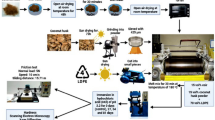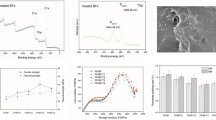Abstract
Nanocalcium carbonate (CaCO3) was successfully adhered to the surface of bamboo fiber (BF) via both impregnation and blending modification. The BF-, BMBF (bamboo fiber treated by blending modification)- and IMBF (bamboo fiber treated by impregnation modification)-reinforced high-density polyethylene (HDPE) composites were all manufactured by means of extrusion molding. The flexural and impact properties of the composites (the addition of BF, BMBF and IMBF were all 30 wt%) were analyzed. CaCO3 with a loading of 15 wt% had an effect on the performance of the composites. The flexural strength (FS) of the BMBF and IMBF composites increased by 1.09 and 9.36%, respectively, while the differences of the impact strength were insignificant among these, compared to the BF/HDPE composites. The flexural properties of the IMBF/HDPE composites were investigated with different mass fractions of IMBF (5, 10, 15, 20, 30, 50, 60 and 70 wt%). The results showed that the FS of the IMBF/HDPE composites reached a maximum value (58.99 MPa) when the mass fraction of the IMBF was 30 wt% and increased by 50.95% compared to when the mass fraction was 5 wt%. These results were supported by ESEM and fractal dimension analysis in terms of proper distribution of nano-CaCO3 and interfacial adhesion between the IMBF and HDPE matrix. The results revealed that the fractal dimension D of IMBF/HDPE composite with a mass fraction of 30 wt% reached a maximum value (2.2036), which was similar to the FS results. There was a linear correlation between lg (FS) and fractal dimension D, indicating that the fractal dimension was practicable for the IMBF-reinforced HDPE composites. The fractal features could reflect the macro-mechanical properties, and the percentage error of the fitting function was within 10%.







Similar content being viewed by others

References
Ashori A (2008) Wood–plastic composites as promising green-composites for automotive industries. Bioresour Technol 99:4661–4667
Panthapulakkal S, Zereshkian A, Sain M (2006) Preparation and characterization of wheat straw fibers for reinforcing application in injection molded thermoplastic composites. Bioresour Technol 97:265–272
Bismarck A, Baltazar-Y-Jimenez A, Sarlkakis K (2006) Green composites as Panacea? socio- economic aspects of green materials. Environ Dev Sustainability 8:445–463
ODonnell A, Dweib MA, Wool RP (2004) Natural fiber composites with plant oil-based resin. Compos Sci Technol 64:1135–1145
Ku H, Wang H, Pattarachaiyakoop N, Trada M (2011) A review on the tensile properties of natural fiber reinforced polymer composites. Compos Part B 42:856–873
Davoodi MM, Sapuan SM, Ahma D, Aidy A, Khalina A, Jonoobi M (2012) Effect of polybutylene terephthalate (PBT) on impact property improvement of hybrid kenaf/glass epoxy composite. Mater Lett 67:5–7
Gupta MK, Srivastava RK (2016) Mechanical Properties of Hybrid Fibers-Reinforced Polymer Composite: a review. Polym Plast Technol Eng 55:626–642
Banga H, Singh VK, Choudhary SK (2015) Fabrication and study of mechanical properties of bamboo fibre reinforced bio-composites. Innov Syst Des Eng 6:84–98
Dominkovics Z, Dańyádi L, Punkánszky B (2007) Surface modification of wood flour and its effect on the properties of PP/wood composites. Compos Part A 38:1893–1901
Sain M, Suhara P, Law S, Bouilloux A (2005) Interface modification and mechanical properties of natural fiber-polyolefin composite products. J Reinf Plast Compos 24:121–130
Haghdan S, Smith GD (2015) Natural fiber reinforced polyester composites: a literature review. J Reinf Plast Compos 34:1179–1190
Pai AR, Jagtap RN (2015) Surface morphology and mechanical properties of some unique natural fiber reinforced polymer composites: a review. J Mater Environ Sci 6:902–917
Cheng HT, Gao J, Wang G, Shi SQ, Zhang SB, Cai LP (2015) Enhancement of mechanical properties of composites made of calcium carbonate modified bamboo fibers and polypropylene. Holzforschung 69:215–221
Shi J, Shi SQ, Barnes HM, Horstemeyer MF, Wang G (2011) Kenaf bast fibers. Part II: inorganic nanoparticle impregnation for polymer composites. Int J Polym Sci. doi:10.1155/2011/736474,736474
Shen J, Song ZQ, Qian XX (2007) Research progress in strength improvement of the paper containing calcium carbonate filler. China Pulp Pap 26:47–51
Othman R, Zakaria S, Chia CH, Zuriyati A, Isa N (2010) Mechanical and optical properties of CaCO3 lumen-loaded paper: effect of polyethylenimine and alum. Sains Malays 39:435–439
Wang CC, Xian Y, Cheng HT, Li WY, Zhang SB (2015) Tensile properties of bamboo fiber-reinforced polypropylene composites modified by impregnation with calcium carbonate nanoparticles. Bioresour 10:6783–6796
Wang CC, Song W, Cheng HT, Yu XF, Li WY, Zhang SB (2016) Dipping modification with nano-CaCO3 to improve tensile properties of individual bamboo fiber for developing bamboo- plastic composite. J Nat Fibers 13:737–748
Liang K, Shi SQ, Wang G (2014) Effect of impregnated inorganic nanoparticles on the properties of the kenaf bast. Fibers 2:242–254
Kalaprasad G, Joseph K, Thomas S, Pavithran C (1997) Theoretical modelling of tensile properties of short sisal fibre-reinforced low-density polyethylene composites. J Mater Sci 32:4261–4267. doi:10.1177/0731684411430559
Sebastien M, Ahmed K, Fouad E, Abdelkader C, Karl E, Michael PW (2010) Application of micromechanical models to tensile properties of wood-plastic composites. Wood Sci Technol 45:521–532
Underwood EE, Banerji K (1986) Fractals in fractography. Mater Sci Eng 80:1–4
Pande CS, Richards LR, Smith S (1987) Fractal characteristics of fractured surfaces. J Mat Sci Lett 6:295–301
Richards LE, Dempsey BD (1988) Fractal characterization of fractured surfaces in Ti-4.5Al-5.0 Mo-1.5Cr (Corona 5). Scr Metall 22:687–689
Hill TJ, Mecholsky JJ, Anusavice AJ (2000) Fractal analysis of toughening behavior in 3BaO.5SiO2 glass-ceramics. J Am Ceram Soc 83:545–554
Mecholsky JJ Jr, West JK, Passoja DE (2002) Fractal dimension as a characterization of free volume created during fracture in brittle materials. Philos Mag A 82:3163–3176
Hassan MM, Wagner MH (2016) Surface modification of natural fibers for reinforced polymer composites: a critical review. Rev Adhes Adhes 4:1–46
Chinese standard GB/T 742-2008, Fibrous raw material, pulp, paper and board determination of ash. The State Standard of the People’s Republic of China, Beijing
ASTM standard D618-08, Standard practice for conditioning plastics for testing. American Society for Testing Materials, Philadelphia
ASTM standard D790-10, Standard test methods for flexural properties of unreinforced and reinforced plastics and electrical insulating materials. American Society for Testing Materials, Philadelphia
ASTM standard D6110-10, Standard test method for determining the charpy impact resistance of notched specimens of plastics. American Society for Testing Materials, Philadelphia
Li ZC, Ji CY (2006) Calculation of weed fractural dimension based on image analysis. Trans Chin Soc Agric Eng 22:175–178
Salemane MG, Luyt AS (2006) Thermal and mechanical properties of polypropylene-wood powder composites. J Appl Polym Sci 100:4173–4180
Qazviniha MR, Abdouss M, Musavi M, Mazinani S, Kalaee M (2016) Physical and mechanical properties of SEBS/polypropylene nanocomposites reinforced by nano CaCO3. Material Werkst 47:323–325
Wong KJ, Zahi S, Low KO, Lim CC (2010) Fracture characterisation of short bamboo fibre reinforced polyester composites. Mater Des 31:4147–4154
Alawar A, Hamed AM, Al-Kaabi K (2009) Characterization of treated date palm tree fiber as composite reinforcement. Compos Part B 40:601–606
Cantero G, Arbelaiz A, Llano-Ponte R, Mondragon I (2003) Effects of fibre treatment on wettability and mechanical behaviour of flax/polypropylene composites. Compos Sci Technol 63:1247–1254
Li P, Wu QL, Tao YB (2013) Fractal dimension analysis of void size in wood-strand composites based on X-ray computer tomography images. Holzforschung 67:177–182
Qiang T, Yu DM, Gao HH (2012) Impact strength and fractal characteristic of PLA-based wood plastic composites. Appl Mech Mater 172–174:683–686
Acknowledgements
This study was funded by the Fundamental Research Funds of the International Centre for Bamboo and Rattan (1632016001), the Co-Constructing Project of Beijing City Board of Education, National Natural Science Foundation of China (31670571), Beijing Natural Science Foundation (6162019) and the Zhejiang Province Co-Constructing Project (CZXC201410).
Author information
Authors and Affiliations
Corresponding authors
Rights and permissions
About this article
Cite this article
Wang, C., Wang, S., Cheng, H. et al. Mechanical properties and prediction for nanocalcium carbonate-treated bamboo fiber/high-density polyethylene composites. J Mater Sci 52, 11482–11495 (2017). https://doi.org/10.1007/s10853-017-1285-1
Received:
Accepted:
Published:
Issue Date:
DOI: https://doi.org/10.1007/s10853-017-1285-1



